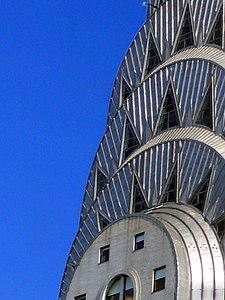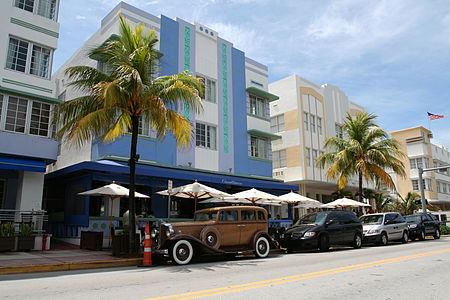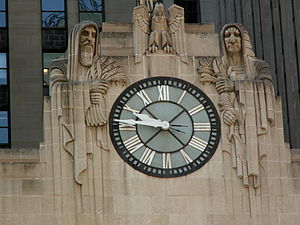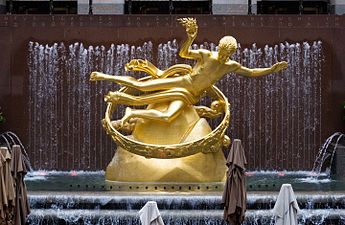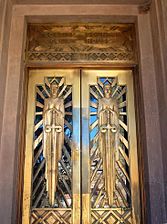Art Deco in the United States
Streamline locomotive (1939));
Delano and National Hotels, Miami Beach (1947 and 1940); Chrysler Building, New York City (1930); Prometheus statue at Rockefeller Center (1930) | |
| Years active | 1919-1939 |
|---|---|
| Location | United States |
The Art Deco style, which originated in France just before World War I, had an important impact on architecture and design in the United States in the 1920s and 1930s. The most famous examples were the skyscrapers of New York, including the Empire State Building, Chrysler Building, and Rockefeller Center in New York City. It combined modern aesthetics, fine craftsmanship and expensive materials, and became the symbol of luxury and modernity. While rarely used in residences, it was frequently used for office buildings, government buildings, train stations, movie theaters, diners and department stores. It also was frequently used in furniture, and in the design of automobiles, ocean liners, and everyday objects such as toasters and radio sets. In the late 1930s, during the Great Depression, it featured prominently in the architecture of the immense public works projects sponsored by the Works Progress Administration and the Public Works Administration, such as the Golden Gate Bridge and Hoover Dam. The style competed throughout the period with the modernist architecture, and came to an abrupt end in 1939 with the beginning of World War II. The style was rediscovered in the1960s, and many of the original buildings have been restored and are now historical landmarks.
Architecture
Skyscrapers
-
Detail of ornament on the Chrysler building crown
-
Chrysler Building in New York City, (1928–30)
-
Radiator ornament decoration on the Chrysler Building
-
The Empire State Building (1931)
-
Crown of the RCA Victor Building (now the Comcast Building) (1930–31)
-
Entrance of the Fisher Building in Detroit, Michigan (1928)
-
Lobby of the Fisher Building in Detroit, Michigan, (1928)
-
Riverside Plaza Building, formerly The Daily News Building, in Chicago, Illinois (1928–30)
-
Buffalo City Hall, Buffalo, New York, Dietel, Wade & Jones, 1931.
-
City Hall of Los Angeles, California (1928)
The Art Deco style had been born in Paris, but no buildings were permitted in that city which were higher than Notre Dame Cathedral (with the sole exception of the Eiffel Tower). As a result, the United States soon took the lead in building tall buildings. The first skyscrapers had been built in Chicago in the 1880s in the Beaux-Arts or neoclassical style. In the 1920s New York architects used the new Art Deco style to build the Chrysler Building and the Empire State Building. The Empire State building was the tallest building in the world for forty years.
The decoration of the interior and exterior of the skyscrapers was classic Art Deco, with geometric shapes and zigzag patterns. The Chrysler Building, by William Van Alen (1928–30), updated the traditional gargoyles on Gothic Cathedrals with sculptures on the building corners in the shape of Chrysler radiator ornaments.[1]
Another major landmark of the style was the RCA Victor Building (now the General Electric Building), by John Walter Cross. It was covered from top to bottom with zig-zags and geometric patterns, and had a highly ornamental crown with geometric spires and lightning bolts of stone. The exterior featured bas-relief sculptures by Leo Friedlander and Lee Lawrie, and a mosaic by Barry Faulkner that required more than a million pieces of enamel and glass.
While the skyscraper Art Deco style was mostly used for corporate office buildings, it also became popular for government buildings, since all city offices could be contained in one building on a minimal amount of land. The city halls of Los Angeles, California and Buffalo, New York were built in the style, as well as the new capital building of the State of Louisiana.
Movie theaters
-
Interior of Grauman's Egyptian Theater (1922) in Hollywood, California
-
Four-story high grand lobby of the Paramount Theater, Oakland (1932)
-
Paramount Theater, Oakland; detail of the mosaic facade (1932)
-
The stage of Radio City Music Hall in New York City (1932)
Another important genre of Art Deco buildings is the movie theater. The Art Deco period coincided with the birth of the talking motion picture, and the age of enormous and lavishly decorated movie theaters. Many of these movie theaters still survive, though many have been divided in the interior into smaller screening halls.
Among the most famous examples are Grauman's Egyptian Theater in Hollywood (1922), and the Paramount Theater (Oakland, California) in Oakland, California, which had a four-story high grand lobby, entered through twenty-seven doors, and could seat 3,746 people.[2]
Radio City Music Hall, located within the skyscraper complex of Rockefeller Center in New York City, was originally a theater for stage shows when it opened in 1932, but it quickly changed to a movie theater, the largest in the United States. It seats more than five thousand people, and still features a stage show of dancers before the film showings.
In the 1930s, the streamline style appeared in movie theaters in smaller cities. The movie theater in Normal, Illinois (1937) is a classic surviving example.
Department stores and office buildings
-
Bullocks Wilshire, Los Angeles, John and Donald Parkinson, 1929
-
The facade of the Niagara Mohawk Building, in Syracuse, New York, (1932), a power utility company, features a statue of "The Spirit of Light"
-
Detail of the Kansas City Power and Light Building in Kansas City, Missouri (1931)
-
Interior of the Guardian Building (originally the Union Trust Building) in Detroit, Michigan (1928)
-
Lobby of the 450 Sutter Street building in San Francisco, by Timothy L. Pflueger (1929)
Following the lead of the skyscrapers of New York City, smaller in scale but no less ambitious in design, Art Deco office buildings and department stores appeared in cities across the United States. They were rarely built by banks, which wanted to appear conservative, but were often built by retail chains, public utilities, automobile companies and technology companies, which wanted to express modernity and progress. Syracuse, New York is home to the Niagara Mohawk Building, in Syracuse, New York, completed in 1932. was originally the home of the nation's largest electricity supplier. The facade, by the firm of [Bley and Lyman, was designed to express the power and modernity of electricity; it features a statue called "The Spirit of Light" 8.5 meters hight, made of stainless steel, as the central element of the facade. The Guardian Building, originally the Union Trust Building, is a rare example of a bank or financial institution using Art Deco. Its interior decoration was so elaborate that it became known as the "Cathedral of Commerce". [3]
The San Francisco architect Timothy L. Pflueger best known for the Paramount Theater in Oakland, California, was another proponent of lavish Art Deco interiors and facades on office buildings. The interior of his downtown San Francisco office building, 450 Sutter Street, opened in 1929, was entirely covered with hieroglyphic-like designs and ornament, resembling a giant tapestry. [4]
The Streamline style
-
Chrome-plated table lamp by Donald Deskey (1927-31)
-
Chrysler Airflow sedan, designed by Carl Breer (1934)
-
Streamlined locomotive of the New York Central Railroad (1939)
-
The Pan-Pacific Auditorium in Los Angeles (1935)
-
The San Francisco Maritime Museum (1936)
Streamline Moderne (or Streamline) was a variety of Art Deco which emerged during the mid-1930s. The architectural style was more sober and less decorative than earlier Art Deco buildings, more in tune with the somber good of the Great Depression. Buildings in the style often resembled land bound ships, with rounded corners, long horizontal lines, iron railings, and sometimes nautical features. Notable examples include the San Francisco Maritime Museum (1936), originally built as a public bath house next to the beach, and the Pan Pacific Auditorium in Los Angeles, built in 1935, and closed in 1978. It was declared an historic landmark, but it was destroyed by a fire in 1989.
The style of decoration and industrial design was influenced by modern aerodynamic principles developed for aviation and ballistics to reduce air friction at high velocities. The bullet shapes were applied by designers to cars, trains, ships, and even objects not intended to move, such as refrigerators, gas pumps, and buildings. One of the first production vehicles in this style was the Chrysler Airflow of 1933. It was unsuccessful commercially, but the beauty and functionality of its design set a precedent; streamline moderne meant modernity. It continued to be used in car design well after World War II.[5][6][7][8]
Train stations and airports
-
The Union Terminal in Cincinnati, Ohio, (1933) is now an art museum and cultural center.
-
Union Station in Los Angeles (1939) is a mixture of Art Deco, Streamline Moderne, and Spanish Mission Revival
-
The Marine Air Terminal at La Guardia Airport (1937) was the New York terminal for the flights of Pan Am Clipper flying boats.
Art Deco was often associated with airplanes, trains and airships, and was frequently chosen as the style for new transport terminals. The huge semi-dome of the *The Cincinnati Union Terminal (1933) measures 180 feet (55 m) wide and 106 feet (32 m) high.[9] After the decline of railroad travel, most of the building was converted to other uses, and is now the Cincinnati Museum Center.
The Marine Air Terminal at La Guardia Airport, built in 1939, was the first terminal for overseas flights from New York; it served the flying boats of Pan American World Airways which landed in the harbor. It survived destruction, and still contains a notable Art Deco mural called Flight, which was destroyed and then restored in the 1980s.
Union Station in Los Angeles was partially designed by John Parkinson and Donald B. Parkinson (the Parkinsons) who had also designed Los Angeles City Hall and other landmark Los Angeles buildings. The structure combines Art Deco, Mission Revival, and Streamline Moderne style, with architectural details such as eight-pointed stars, and even elements of Dutch Colonial Revival architecture.[10]
Hotels and Resorts- the Miami Beach style
-
Entrance of the Waldorf Astoria Hotel (1929)
-
Miami Beach Architectural District from 1920s-1930s
-
The Tides Hotel on Ocean Drive, Miami (1933)
-
The Delano South Beach (1947) and National Hotel (1943) in Miami Beach
The Art Deco period saw an enormous increase in travel and tourism, by trains, automobiles, and airplanes. Several luxury hotels were built in the new style; The Waldorf-Astoria on Park Avenue in New York City, built in 1929 to replace a beaux-arts style building from the 1890s, was the tallest and largest hotel in the world when it was built.
The city of Miami Beach, Florida developed its own particular variant of Art Deco, and the style remained popular there until the late 1940s, well after other American cities. it became a popular tourist destination in the 1920s and 1930s, particularly attracting visitors from the Northeast United States during the winter. A large number of Art Deco hotels were built, which have been grouped together into an historical area, the Miami Beach Architectural District, and preserved, and many have been restored to their original appearance.[11][12] The district has an area of about one square kilometer, and contains both hotels and secondary residences, all about the same height, none higher than twelve or thirteen stories. Most have classic Art Deco characteristics; clear geometric shapes spread out horizontally; aerodynamic streamline features; and often a central tower breaking the horizontal, topped by a spire or dome. A particular Miami Art Deco feature is the palette of pastel colors, alternating with white stucco. The decoration features herons, sea shells, palm trees and sunrises and sunsets. The neon lighting at night highlights the Art Deco atmosphere. [13]
Diners and roadside architecture
-
The Modern Diner in Pawtucket, Rhode Island (1940) is modeled after streamlined railroad car.
Because of its high cost of construction, Art Deco was usually used only in large office buildings, government buildings and theaters, but it was sometimes used in smaller structures, such as diners and gas stations, particularly along highways. A notable example is the U-Drop Inn in Shamrock, Texas, located along U.S. Highway 66. It was built in 1936, and is now owned by the City of Shamrock, and is an historical landmark.
In the late 1930s and early 1940s, a number of diners modeled after the cars of streamlined trains were produced, and appeared in different cities in the United States. In a few cases, reai railroad cars were transformed into diners. A few survive, including the Modern Diner in Pawtucket, Rhode Island which is a registered landmark.
Fine Art
Murals
-
Mural "Tragic Prelude" depicting abolitionist John Brown in the Kansas State Capitol building, by John Steuart Curry (1930)
-
Part of "Detroit Industry"' mural by Diego Rivera in the Detroit Institute of Arts (1932-33)
-
A portion of a mural depicting the History of Southern Illinois, commissioned by the Federal Art Project for the lLibrary of the University of Southern Illinois (1935)
-
Workers sorting the mail, a mural in the U.S. Customs House in New York by Reginald Marsh (1936)
-
Mural Art in the Tropics by Rockwell Kent in the William Jefferson Clinton Federal Building (1938)
There was no specific Art Deco style of painting in the United States, though paintings were often used as decoration, especially in government buildings and office buildings. In the 1932 the Public Works of Art Project was created to give work to artists unemployed because the Great Depression. In a year, it commissioned more than fifteen thousand works of art. It was succeeded in 1935 by the Federal Arts Project of the Works Progress Administration, or WPA. prominent American artists were commissioned by the Federal Art Project to paint murals in government buildings, hospitals, airports, schools and universities. Some the America's most famous artists, including Grant Wood, Reginald Marsh, Georgia O'Keefe and Maxine Albro took part in the program. The celebrated Mexican painter Diego Rivera also took part in the program, painting a mural. The paintings were in a variety of styles, including regionalism, social realism, and American scenic painting.
A few murals were also commissioned for Art Deco skyscrapers, notably Rockefeller Center in New York. Two murals were commissioned for the lobby, one by John Steuart Curry and another by Diego Rivera. The owners of the building, the Rockefeller family, discovered that Rivera, a Communist, had slipped an image of Lenin into a crowd in the painting, and had it destroyed. [14] The mural was replaced with another by the Spanish artist José Maria Sert. [15]
Sculpture
-
Aluminum statue of Ceres atop the Chicago Board of Trade Building (1930)
-
Clock of the Chicago Board of Trade (1930)
-
Lobby clock in Rockefeller Center
-
Sculpture on the wall of Rockefeller Center
-
Doors of Cochise County Courthouse in Bisbee, Arizona
One of the largest Art Deco sculptures is the statue of Ceres, the goddess of grain and fertility, at the top of the Chicago Board of Trade. Made of aluminum, It stands 31 feet (9.4 meters) tall, and weighs 6,500 pounds. Ceres was chosen because the Chicago Board of Trade was one of he largest grain and commodities markets in the world.
Graphic Arts
-
Poster for Chicago World's Fair (1933)
-
WPA Poster warning against crossing the street against the light (1937)
-
WPA poster advertising Port of Philadelphia (1937)
-
WPA "Swim for Health" poster (1938)
-
WPA Tourism promotion poster for state of Pennyslvania (1938)
The Art Deco style appeared early in the graphic arts, in the years just before World War I. It appeared in Paris in the posters and the costume designs of Leon Bakst for the Ballets Russes, and in the catalogs of the fashion designers Paul Poiret. The illustrations of Georges Barbier, and Georges Lepape and the images in the fashion magazine La Gazette du bon ton perfectly captured the elegance and sensuality of the style. In the 1920s, the look changed; the fashions stressed were more casual, sportive and daring, with the woman models usually smoking cigarettes. American fashion magazines such as Vogue, Vanity Fair and Harper's Bazaar quickly picked up the new style and popularized it in the United States. It also influenced the work of American book illustrators such as Rockwell Kent.[16]
In the 1930s a new genre of posters appeared in the United States during the Great Depression. The Federal Art Project hired American artists to create posters to promote tourism and cultural events.
Examples of Art Deco in the United States
For a list of notable Art Deco buildings in the United States by State, see List of Art Deco architecture#United States
References
Notes and citations
- ^ Morel2012, p. 151.
- ^ Stone, Susannah Harris. The Oakland Paramount, Lancaster-Miller Publishers (1982) - ISBN 0-89581-607-5
- ^ Duncan 1988, p. 193.
- ^ Duncan 1988, p. 198.
- ^ Gartman, David (1994). Auto Opium. Routledge. pp. 122–124. ISBN 978-0-415-10572-9.
- ^ "Curves of Steel: Streamlined Automobile Design". Phoenix Art Museum. 2007. Retrieved 1 September 2010.
- ^ Armi, C. Edson (1989). The Art of American Car Design. Pennsylvania State University Press. p. 66. ISBN 978-0-271-00479-2.
- ^ Hinckley, James (2005). The Big Book of Car Culture: The Armchair Guide to Automotive Americana. MotorBooks/MBI Publishing. p. 239. ISBN 978-0-7603-1965-9.
- ^ Cincinnati Union Terminal Architectural Information Sheet. Cincinnati Museum Center. Retrieved on February 8, 2010
- ^ Waldie, D.J. (May 1, 2014) "Union Station: L.A.'s nearly perfect time machine" Op-Ed, Los Angeles Times.
- ^ "Our Mission Statemente". Miami Design Preservation League. Retrieved 7 December 2012.
- ^ Brown, Joseph (2009). "Miami Beach Art Deco". Miami Beach MagazineFebruary 2010. Archived from the original on 31 January 2010.
{{cite web}}: Unknown parameter|deadurl=ignored (|url-status=suggested) (help) - ^ Duncan 1988, pp. 203–205.
- ^ "Archibald MacLeish Criticism". Enotes.com. Retrieved 2011-12-08.
- ^ Moret 2012, p. 155.
- ^ Duncan 1988, pp. 148–150.
Bibliography
- Bayer, Patricia (1999). Art Deco Architecture: Design, Decoration and Detail from the Twenties and Thirties. Thames & Hudson. ISBN 978-0-500-28149-9.
{{cite book}}: Invalid|ref=harv(help) - Benton, Charlotte; Benton, Tim; Wood, Ghislaine; Baddeley, Oriana (2003). Art Deco: 1910–1939. Bulfinch. ISBN 978-0-8212-2834-0.
{{cite book}}: Invalid|ref=harv(help) - Breeze, Carla (2003). American Art Deco: Modernistic Architecture and Regionalism. W. W. Norton. ISBN 978-0-393-01970-4.
- Duncan, Alastair (1988). Art déco. Thames & Hudson. ISBN 2-87811-003-X.
- Duncan, Alaistair (2009). Art Deco Complete: The Definitive Guide to the Decorative Arts of the 1920s and 1930s. Abrams. ISBN 978-0-8109-8046-4.
- Gallagher, Fiona (2002). Christie's Art Deco. Pavilion Books. ISBN 978-1-86205-509-4.
- Hillier, Bevis (1968). Art Deco of the 20s and 30s. Studio Vista. ISBN 978-0-289-27788-1.
{{cite book}}: Invalid|ref=harv(help) - Long, Christopher (2007). Paul T. Frankl and Modern American Design. Yale University Press. ISBN 0-300-12102-4.
- Lucie-Smith, Edward (1996). Art Deco Painting. Phaidon Press. ISBN 978-0-7148-3576-1.
- Morel, Guillaume (2012). Art Déco (in French). Éditions Place des Victoires. ISBN 978-2-8099-0701-8.
- Savage, Rebecca Binno; Kowalski, Greg (2004). Art Deco in Detroit (Images of America). Arcadia. ISBN 978-0-7385-3228-8.
- Vincent, G.K. (2008). A History of Du Cane Court: Land, Architecture, People and Politics. Woodbine Press. ISBN 978-0-9541675-1-6.
- Ward, Mary; Ward, Neville (1978). Home in the Twenties and Thirties. Ian Allan. ISBN 0-7110-0785-3.
See also
- Art Deco
- List of Art Deco architecture
- Art Deco Jewelry estate jewelry
- 1933 Chicago World's Fair Century of Progress
- Clockarium
- 1936 Fair Park built for Texas Centennial Exposition
- Art Deco stamps
- International style
- List of Art Deco architecture






